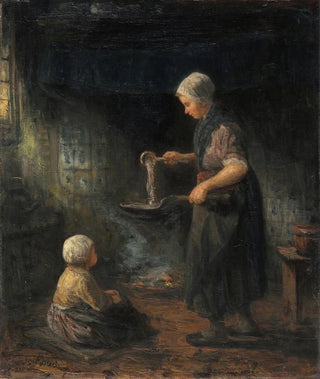Art print | Les crêpes - Jozef Israëls


View from behind

Frame (optional)
In the captivating world of 19th-century Dutch painting, the art print "Les crêpes" by Jozef Israëls stands out for its intimacy and emotional depth. This canvas, which captures a moment of everyday life, evokes not only the simplicity of gestures but also the beauty of shared moments. Observing this scene, the viewer is transported to a world where time seems to stand still, where the warmth of the kitchen and the aroma of crêpes create an atmosphere of family harmony. The soft light flooding the room, the meticulous details of the characters and objects, testify to an exceptional craftsmanship that invites contemplation.
Style and uniqueness of the work
Israëls's style is characterized by a realistic approach, but also by an impressionist sensitivity that transcends mere visual representation. In "Les crêpes," the warm, earthy color palette contributes to the scene's authenticity. The faces of the characters, imbued with tenderness and expression, reveal psychological depth that invites empathy. The artist succeeds in capturing the very essence of domestic life, where each gesture is loaded with meaning. The textures, whether of the clothing fabric or the delicacy of the crêpes, are rendered with precision that demonstrates immense talent. This art print reminds us that beauty can be found in the most ordinary moments—a timeless lesson that still resonates today.
The artist and his influence
Jozef Israëls, an emblematic figure of the realist movement, knew how to blend tradition and modernity throughout his career. Born in Groningen in 1824, he was influenced by the great masters of Dutch painting, while developing a personal style that resonates with the concerns of his time. His work reflects profound humanity, a particular attention to the details of daily life, and an ability to evoke universal emotions. Israëls was also a mentor to many artists of his era, contributing to the formation of a new generation of painters who sought to depict reality with increased sensitivity. His vision

Matte finish

View from behind

Frame (optional)
In the captivating world of 19th-century Dutch painting, the art print "Les crêpes" by Jozef Israëls stands out for its intimacy and emotional depth. This canvas, which captures a moment of everyday life, evokes not only the simplicity of gestures but also the beauty of shared moments. Observing this scene, the viewer is transported to a world where time seems to stand still, where the warmth of the kitchen and the aroma of crêpes create an atmosphere of family harmony. The soft light flooding the room, the meticulous details of the characters and objects, testify to an exceptional craftsmanship that invites contemplation.
Style and uniqueness of the work
Israëls's style is characterized by a realistic approach, but also by an impressionist sensitivity that transcends mere visual representation. In "Les crêpes," the warm, earthy color palette contributes to the scene's authenticity. The faces of the characters, imbued with tenderness and expression, reveal psychological depth that invites empathy. The artist succeeds in capturing the very essence of domestic life, where each gesture is loaded with meaning. The textures, whether of the clothing fabric or the delicacy of the crêpes, are rendered with precision that demonstrates immense talent. This art print reminds us that beauty can be found in the most ordinary moments—a timeless lesson that still resonates today.
The artist and his influence
Jozef Israëls, an emblematic figure of the realist movement, knew how to blend tradition and modernity throughout his career. Born in Groningen in 1824, he was influenced by the great masters of Dutch painting, while developing a personal style that resonates with the concerns of his time. His work reflects profound humanity, a particular attention to the details of daily life, and an ability to evoke universal emotions. Israëls was also a mentor to many artists of his era, contributing to the formation of a new generation of painters who sought to depict reality with increased sensitivity. His vision






